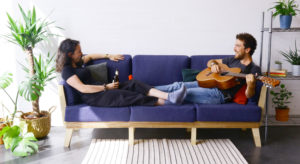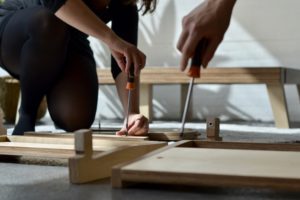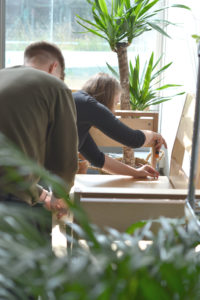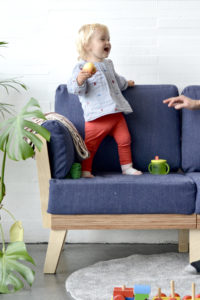Sofa Forlife; designing for a circular economy

Sofa Forlife:
Currently, we live in a society which conforms to a linear economy model; we purchase, we consume and we throw away. This is not sustainable and is detrimental to the health of our planet.
Designed Forlife takes action by designing products that facilitate a circular economy. Their first product is the Sofa Forlife, a modular piece of furniture designed following all the principles of the circular economy.

By talking to recycling centres, second-hand shops and anyone who has owned a sofa, Designed Forlife discovered that every single sofa ends up in landfill. This is caused by the unrecyclable materials used and an inability to clean, transport or repair sofas easily. Further, users just wanted a change in colour, sizing or style, which results in an early discard of the product.
With these problems in mind, the Sofa Forlife was designed. It uses renewable and recyclable materials and the whole sofa can be disassembled into material components, which enables recycling.

Its modular design enables you to change the colour, the size and style of the sofa by updating and adding components. This is cheaper than buying a whole new sofa and reduces waste.
It is designed to last and change with our needs thanks to a system that allows used elements to get back to the producer for refurbishing, re-use or recycle.
The biggest lesson we learned during our journey into the world of circular design is that sustainability is a progress not a fixed asset. We analysed many different materials to select those that are renewable, available, manufacturable and recyclable, without compromising quality.
Wood for the sofa structure:
We wanted to use hardwood to ensure longevity, however, most available hardwoods are tropical which aren’t sustainable. We decided on European Birch Plywood a fast-growing local wood and hard due to its composition. The glues currently used in plywood aren’t sustainable, but there is progress in the wood industry to use lignin, a natural wooden glue in future plywood. At the end of its lifetime, the plywood can be shredded and used as animal bedding or for other purposes.

Textiles:
We did not want to use fire retardants on our fabrics, therefore the textile of choice needed to be naturally fire retardant. Wool seemed like an obvious choice, but as 100% wool shrinks while washing we decided on Patina Fabrics which consist of 69% wool, 22% flax, 8% polyamide and 1% viscose which makes it both washable and fire retardant. We also love the colour range and feel of Patina. At the end of the cover’s lifetime, we will be able to give some parts to a local sewing company to create wallets and other smaller items. The rest of the fabrics will be compiled and sent away to create Feltex, a material used in current mattresses.
Cushions:
Most sofas use foams from fossil fuels which are extremely flammable and therefore are treated with hazardous fire retardants. We spent a lot of time developing different cushion alternatives made from renewable materials that can keep their shape, retain comfort and could be recycled afterwards. Unfortunately, none of the dozens of variations tried passed all of our requirements, especially in terms of comfort. Therefore, we are currently looking to use traditional foams that use less hazardous fire retardants until some more sustainable cushioning alternative enters the market.
Modularity:
Apart from the material choice, the modularity is the main driver for circular economy design. The way that the sofa has been designed, through countless iterations and from the first sketch to the fully-working final model, has enabled its modularity. The sofa can be assembled in around 5 minutes using nothing but a screwdriver and can be easily disassembled back into its flat-pack form in the same amount of time.

Users are able to update and replace components such as legs, cushion covers, and armrests over the lifetime of the sofa as components begin to wear out or their life situations change.
The flatpack design fits through doorways and up narrow stairwells and it allows you to transport your sofa in the boot of your car. This encourages you to keep your sofa even if you move frequently or you can sell it second-hand.
Recycle:
We incentivise the user to return the sofa to us and we can inspect the components for potential reuse. If that is not possible, we will be able to work with local wood, textile and recycling companies to ensure a second use for the materials included.
Almost all the objects that surround us have a short life and will soon become waste. This sofa will not.

Support:
Designed Forlife is about to embark on an exciting Kickstarter campaign in March 2020, where people have the chance to buy into the first batch of Sofa Forlife’s at a discounted price. For more information on the Kickstarter campaign, you can visit their website at www.sofaforlife.co.uk, or say hello on social media, at the handle @sofaforlife.








